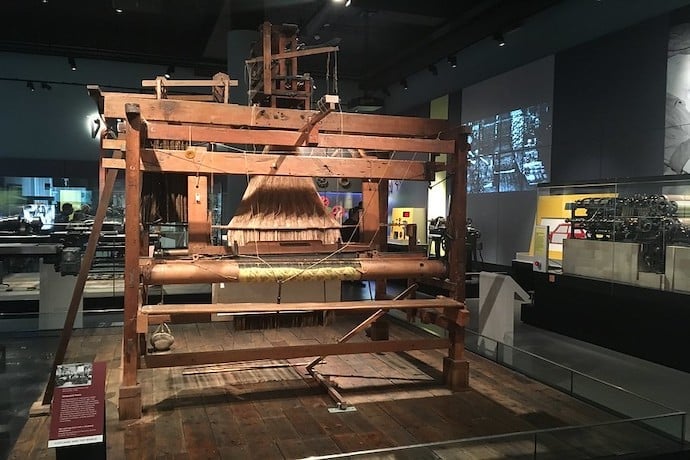In the heart of the Marais district of Paris lies the museum of the Conservatoire National Des Arts et Métiers, a university devoted to technology and innovation since its founding in 1794. In the attached museum you will find many of the greatest innovations of the 17th, 18th, and 19th centuries like Foucault’s pendulum and Blaise Pascal’s mechanical calculator.
However, last summer I visited this museum to see one particular invention: The Jacquard Loom. This loom invented by Joseph Jacquard in 1801 was the first programmable textile loom. What makes this invention so remarkable (and an early predecessor to the computer) is that it was programmed by a series of punch cards that instructed the loom to either lower or raise certain threads. Needles would either be able to pass through the card where there was a hole, or be prevented from doing so–a very early binary code.
The invention of the programmable loom enabled a new revolution in textiles as patterned fabrics could be produced faster and more cheaply than ever before. Additionally, this method of saving “programs” to punch cards persisted well into the computer age. Punch cards were used as a cost-effective way to program digital computers well into the 1980s. This remarkable machine sent shockwaves throughout Europe as many others copied its use of punch cards, and it also influenced an inventor across the English channel as well.
Charles Babbage was a mathematician and founder of the Royal Astronomical Society. He was heavily influenced by Jacquard, and he created what some believe was the first computer, the Difference Engine, in 1814. Used to mechanically compute the mathematical tables for polynomial functions, the engine was never completed, but you can see a replica in the Science Museum in London.
Babbage also went on to draw up plans for a computer called the Analytical Engine in 1837 that used Jacquard’s idea of punched cards as programmable input.
Babbage was very farsighted when it came to mechanical inventions, and his most important work was in designing the Analytical Engine. It was the first mechanical computation machine that had the ability to run multiple algorithms, had separate memory for data and programs, and had the first input/ output module. The Science Museum even has on display a printer for the computer that Babbage had envisioned, but never built.
While innovation in today’s world looks much different, in the 1800s the invention of a machine to solve a specific problem was a very big deal. Whether this problem was lowering the cost of patterned fabric or predicting the tides, the greatest minds of this generation harnessed
the power of machinery, electricity, and steam to build some of the most complex innovations ever seen.
Remarkably, many of these machines were kept in use well into the digital age of the mid-20th
century. Like Jacquard’s punch cards, the Harris-Fisher machine, lovingly named “Old Brass Brains”, was an analog machine used to predict the tides for the US Coast Guard until it was replaced by a digital computer in 1965.
One of the reasons why predicting the tides and computing polynomial tables is still relevant is that we once again have some very complicated and urgent problems facing us today. The continuing CO2 crisis that is driving extreme weather across the globe presents many related problems that humans need to solve in the coming decades. New battery technology, fusion power, and carbon capture are all examples of very specific problems that cannot be solved through computer software. These problems will require incredibly innovative and specific engineering solutions.
We once again need to turn to the greatest minds of our time, our Babbages, Jacquards, Kelvins, Pasteurs, and Curies to develop the innovations of the 21st century. While climate-specific problems continue to be tantamount, other fields such as biomedical research and renewable energy are incredibly important and will also test the boundaries of engineering and science in the coming years. Hopefully, we can learn from these inventors that turned a spark into a design long ago and find new paths into our future.
Learn More
Jacquard Machine
https://en.wikipedia.org/wiki/Jacquard_machine
Jacquard Loom, National Museum of Scotland
https://www.nms.ac.uk/explore-our-collections/stories/science-and-technology/jacquard-loom/
How the Jacquard Loom Led to Computer Technology
https://www.youtube.com/watch?v=MQzpLLhN0fY
Analytical Engine
https://en.wikipedia.org/wiki/Analytical_Engine
Punch Cards
https://www.computerhope.com/jargon/p/punccard.htm
Punch Cards for Data Processing
https://www.si.edu/spotlight/punch-cards/punch-cards-data-processing
Conservatoire National des Arts et Métiers
https://en.wikipedia.org/wiki/Conservatoire_national_des_arts_et_m%C3%A9tiers

